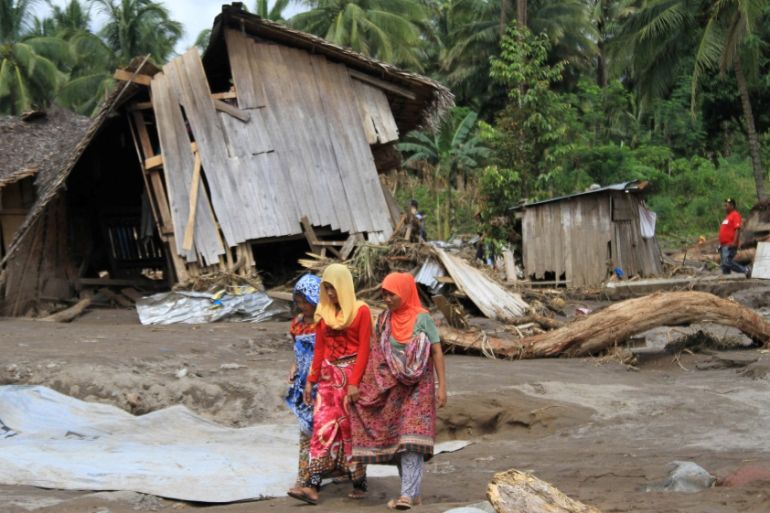Villagers struggle in aftermath of Philippines storm
Rural communities in the Philippines are trying to pick up the pieces after losing everything in Tropical Storm Tembin.

Lanao Del Norte, Philippines – The village of Dalama in the town of Tubod now looks like a dry riverbed, except for the few houses that managed to cling to their foundations – pieces of wood and concrete lodged in the sand among logs and boulders. Here and there, people sift through the debris hoping to find something of value.
But they are not the owners – the owners are either elsewhere or dead.
Keep reading
list of 4 itemsTurtles swimming to extinction in Malaysia as male hatchlings feel heat
Could shipping containers be the answer to Ghana’s housing crisis?
Thousands protest against over-tourism in Spain’s Canary Islands
Before Tropical Storm Tembin hit the southern Mindanao region of the Philippines on the morning of December 22, officials of the Tubod municipal government warned Dalama’s residents to evacuate. The fear was that the village, located near a river on the slope of a mountain, could be wiped out by a flash flood or landslide.
That is exactly what occurred.
“It all happened so fast,” the surviving villagers tell anyone who would listen.
“Not even five minutes. The entire village was gone before we realised what was happening.”
Of the 104 homes that used to comprise the village’s Purok-2A neighbourhood, only two remain standing after Tembin, or Vinta, as it is known locally. Rescuers have so far retrieved 32 bodies from the rubble, but they could not take names off the list of 13 villagers still missing because the corpses were disfigured beyond recognition.
‘Ignored warnings’
According to Vicmar Paloma, the local disaster management officer, many of the villagers ignored the evacuation warning because they had weathered past storms.
The people, Paloma said, were “campante” – complacent – because they had heard similar warnings before and nothing had happened.
“So they thought they could just stay. By the time they realised the danger, it was too late,” Paloma told Al Jazeera.
But Marilou Itum, a Dalama resident, believes there was little that could have been done. When she and her husband heard the warning, they first herded their swine into a place they thought was safe. She then went back home to get their eight children and her brother. By then, the flood had engulfed their escape route.
“I told my brother, ‘This is it. I don’t think we’ll get out of this alive.’ We were crying and we didn’t know what to do,” Itum told Al Jazeera as she failed to hold back tears.
In the end, they followed their feet in the other direction – away from the flood and towards the raging river. Luckily, they found an elevated outcrop from where they watched the onslaught of mud and boulders swallow up houses, including their own.
She should be grateful that her entire family is alive, she said. One of her neighbours lost 13 family members, including his parents and grandparents.
But every day, the miracle of their survival gets more and more overshadowed by dark thoughts about their future.
“I had a sewing machine with which I earned a living. I guess that’s gone, too,” she said as she pored over the heap of sticks and scraps that used to be her home. The flood had taken away the pigs they desperately tried to save.
“I don’t know what will become of us,” she said.
‘I can never go back’
Some 400 villagers now live in a nearby schoolhouse and spent Christmas there. Many of them admit not heeding the storm warning right away.
“We’ve heard warnings like those in the past and nothing happened,” Rosemarie Sarabillo told Al Jazeera. She and her three children now occupy a corner of a classroom, which they share with 10 other families.
Sarabillo and her family had a good life in Purok-2A. They were not rich but they were comfortable. But that, too, is now in the past.
She said she did now know whether the government or any aid group would help her family find somewhere to live. The one thing she did know was that Purok-2A of Dalama was no more.
“I can never go back there,” she said, before she began sobbing.
A new beginning
With some 20 major storms passing through the Philippines every year, its people have gotten used to the stories of devastation and suffering that the worst of these rains leave behind.
Still, many communities are caught off-guard when they strike, despite considerable efforts by the national government to inform and equip people against calamities.
The challenging economic and security situation in the Mindanao region leaves its people particularly vulnerable, as was evident in Dalama.
The village lies on a mountainside a good hour’s drive from the Tubod town centre. Much of the road leading to it is unpaved. There are no offices or factories for the people to work in – so they are mostly farmers. But they remain poor because they usually do not own the land they till, but rather work for landlords who live in the city.
Those who save up enough money to buy land do so where they can afford it, in places like remote mountain slopes and river banks. Others just become squatters.
Working hard to make ends meet, these people tend to live a simple life – and it’s fair to say things like climate change and disaster mitigation are not constantly on their minds.
Philippines President Rodrigo Duterte visited Tubod on Wednesday, where he was briefed on the situation by local disaster management officials. Unlike his usual self, he looked glum and spoke mildly.
“We will help. That’s why I’m here,” he said.
“We’re ending the year with a bing-bang of sorrow and agony. I just hope that next year, Allah would be kind enough to give us a new beginning.”
|
|